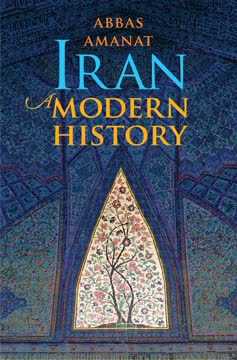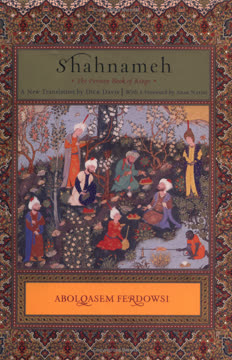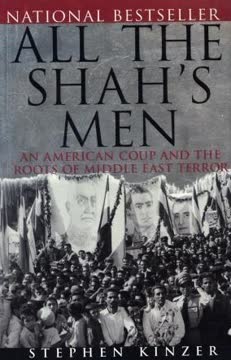Key Takeaways
1. Shi'ism's Rise and Safavid Revolution: A Turning Point
The rise of the Safavid state and assertion of Shi‘ism as religion of the realm at the outset of the sixteenth century (corresponding to the turn of the tenth Islamic century) was a turning point not only for Iran proper but also for the predominantly Sunni neighboring lands.
Religious and Political Shift. The Safavid dynasty's embrace of Shi'ism marked a profound shift in Iran's identity, distinguishing it from its Sunni neighbors and establishing a unique religious and political landscape. This decision had far-reaching consequences, shaping Iran's cultural, social, and political trajectory for centuries to come.
Messianic Beginnings. The Safavid movement initially arose from messianic fervor, attracting Turkmen warriors with promises of worldly and spiritual rewards. However, the dynasty gradually transitioned towards a more orthodox form of Shi'ism, enforced through state power and the influence of Arab jurists.
Global Context. The Safavid revolution occurred amidst a period of significant global transformation, including the rise of other "Gunpowder Empires" and the European Renaissance. While sharing some characteristics with these developments, the Safavid experience remained distinct, shaped by its unique religious and cultural context.
2. Isma'il I: From Charismatic Leader to Enforcer of Shi'a Law
Ruthless and unwavering though Isma‘il and his successors were, the Safavids brought (in a relatively short span of time) a degree of conformity to an otherwise disparate mosaic of local dynasties, ethnicities, and cultures that had divided Iran since Timur’s time a century earlier.
Dual Role. Isma'il I, the founder of the Safavid dynasty, embodied a complex duality, serving as both a charismatic Sufi leader and a ruthless king. This combination of spiritual authority and political power proved crucial in consolidating the Safavid Empire.
Forced Conversion. Isma'il's reign was marked by the forceful imposition of Shi'ism on a predominantly Sunni population. This involved violence, intimidation, and the suppression of Sunni religious institutions, leading to significant social and cultural upheaval.
Patronage of Shi'a Scholars. To solidify Shi'ism, Isma'il invited Arab Shi'a jurists from Jabal 'Amil (present-day Lebanon) to his court. These scholars played a key role in shaping Safavid religious doctrine and institutions, further distinguishing Iran from its Sunni neighbors.
3. Chaldiran's Impact: Halting Expansion and Shaping Identity
The consequences of the Battle of Chaldiran were far reaching. The most immediate were a serious downturn in Safavid revolutionary zeal and, along with it, a melancholic bend in Isma‘il’s personality.
Ottoman Threat. The Battle of Chaldiran in 1514, a decisive defeat for the Safavids at the hands of the Ottoman Empire, marked a turning point in Iranian history. It halted Safavid expansion westward and forced the dynasty to consolidate its power within Iran's geographical boundaries.
Shift in Focus. The defeat at Chaldiran led to a decline in Safavid messianic fervor and a greater emphasis on consolidating Shi'ism within Iran. This involved the development of legal and institutional frameworks, as well as the suppression of unorthodox religious movements.
Limited Access to Mediterranean. The Ottoman victory at Chaldiran also limited Iran's access to the Mediterranean world, hindering its commercial and cultural exchange with Europe. This isolation contributed to Iran's distinct development compared to other empires of the time.
4. Tahmasp I: Consolidating Shi'ism and Navigating Power Dynamics
Tahmasp’s era is remembered as an age of clerical consolidation, when Shi‘i jurists, Arab emigrants, and indigenous Iranians gained prominence in government and in society at large.
Clerical Influence. Tahmasp I's reign witnessed the growing influence of Shi'i jurists in Safavid society. These scholars, often immigrants from Jabal 'Amil, played a key role in shaping religious doctrine, legal practices, and social norms.
Balancing Act. Tahmasp skillfully navigated the complex power dynamics between the Qezilbash, the Turkmen warrior clans who had brought the Safavids to power, and the rising Persian bureaucratic elite. This involved strategic alliances, calculated appointments, and the suppression of dissent.
Shift in Capital. The transfer of the Safavid capital from Tabriz to Qazvin during Tahmasp's reign symbolized a shift in focus from the periphery to the Iranian heartland. This move also reflected a growing emphasis on Persian culture and identity.
5. 'Abbas I: Rebuilding Iran and Engaging with Europe
Crucial to the rudiments of political authority in Iran, and perhaps the oldest in its political culture, is the idea of the shah, the universal title for Iranian kings up to modern times.
Visionary Leadership. 'Abbas I is widely regarded as one of Iran's greatest rulers. He revitalized the Safavid Empire through military reforms, economic development, and cultural patronage, ushering in a golden age of Iranian history.
Military Reforms. 'Abbas I modernized the Safavid army by creating a standing army of slave soldiers (ghulams) equipped with firearms. This reduced the dynasty's reliance on the Qezilbash and strengthened central control.
Economic and Cultural Flourishing. 'Abbas I promoted trade, industry, and the arts, transforming Isfahan into a magnificent capital city. He also established diplomatic and commercial ties with Europe, fostering Iran's earliest encounters with Western modernity.
6. Center and Periphery: The Delicate Balance of Power
Even when the structural deficiencies in the Persian model of government were to be overcome by the ruler or his ministers, there were marginal forces outside the state’s immediate reach.
Tribal Influence. Throughout Iranian history, tribal groups on the periphery of the kingdom have exerted significant influence, often challenging the authority of the central government. Maintaining a balance between the center and the periphery has been a constant challenge for Iranian rulers.
King of Kings. The title "Shahanshah," or King of Kings, reflects the hierarchical nature of Persian political culture. It acknowledges the existence of regional rulers and semiautonomous entities while asserting the supreme authority of the central government.
Geographical Factors. Iran's diverse geography, with its mountains, deserts, and coastlines, has shaped its administrative structure and political dynamics. The difficulty of controlling remote regions has often led to decentralized forms of governance.
7. Culture and Memory: The Enduring Influence of Persian Identity
Beyond their indigenous sociopolitical institutions, Iranians shared distinct cultural memories and religious beliefs, which gave them a degree of communal identity long before the arrival of modern ideologies of nationalism.
Persian Language. The Persian language has served as a unifying force in Iranian history, preserving cultural traditions, literary masterpieces, and shared memories across centuries. Despite periods of political fragmentation, Persian language and culture have helped maintain a sense of Iranian identity.
The Shahnameh. Ferdowsi's Shahnameh, the epic poem recounting Iran's mythical and historical past, has played a crucial role in shaping Iranian national consciousness. It provides a shared narrative, a sense of collective identity, and a framework for understanding Iran's place in the world.
Shi'ism and National Identity. While Shi'ism has been a defining feature of Iranian identity since the Safavid era, it has also coexisted with other cultural and religious traditions. The interplay between Shi'ism and Persian culture has created a unique and complex Iranian identity.
8. The Silenced Voices: Minorities and the Unseen in Iranian Society
Underneath the prevailing social contract, and the elite who presided over it, there endured a vast sector of the population essentially absent from the public space.
Patriarchal Structures. Iranian society has historically been shaped by patriarchal structures, with power and privilege concentrated in the hands of men. Women, religious minorities, and other marginalized groups have often been excluded from public life and subjected to discrimination.
Slavery and Servitude. Slavery and servitude were prevalent in Iran for centuries, with people of African descent and those captured in wars often forced into domestic service. While slavery was officially abolished in the 19th century, its legacy continues to shape Iranian society.
Religious Minorities. Religious minorities, including Zoroastrians, Jews, and Christians, have faced varying degrees of tolerance and persecution throughout Iranian history. The Baha'i faith, a relatively new religion originating in Iran, has been particularly targeted by the state.
9. The Safavid Decline: Internal Strife and External Pressures
The complex set of factors that contributed to the waning of the Safavid Empire and its eventual collapse in the early eighteenth century plunged Iran into periods of nomadic unrest and foreign occupations.
Succession Crisis. The Safavid Empire's decline was precipitated by a series of weak rulers and succession crises. These internal struggles weakened the central government and created opportunities for external enemies to exploit.
Nomadic Invasions. Nomadic groups, particularly the Afghans, posed a significant threat to the Safavid Empire. Their incursions into Iranian territory disrupted trade, devastated agricultural lands, and challenged the authority of the state.
Economic Weakness. The Safavid economy suffered from a number of factors, including declining trade, inflation, and mismanagement. This economic weakness further undermined the empire's ability to defend itself and maintain stability.
10. Nader Shah's Rise and Fall: A Military Interlude
Nader Shah’s expansionist empire proved ephemeral.
Military Genius. Nader Shah, a brilliant military commander, rose to power amidst the chaos following the Safavid collapse. He expelled foreign invaders, restored Iranian sovereignty, and expanded the empire through conquest.
Ruthless Rule. Nader Shah's reign was marked by both military success and extreme brutality. His heavy taxation, forced conscription, and suppression of dissent alienated many of his subjects.
Ephemeral Empire. Nader Shah's empire proved short-lived, collapsing after his assassination in 1747. His conquests were unsustainable, and his legacy was tarnished by his tyranny.
11. Zand Dynasty: A Brief Respite of Prosperity
The Zands, too, only temporarily returned prosperity to southern Iran.
Karim Khan's Wisdom. Karim Khan Zand, a benevolent ruler, emerged from the chaos following Nader Shah's death. He brought a period of peace, stability, and economic prosperity to southern Iran.
Shiraz as a Center. Karim Khan made Shiraz his capital, transforming it into a center of trade, culture, and learning. He commissioned numerous building projects, including the Vakil Bazaar and the Vakil Mosque.
Limited Reach. The Zand dynasty's power was largely confined to southern Iran. It failed to establish lasting control over the entire country, and its rule was ultimately short-lived.
12. Qajar Era Begins: A New Dynasty Forges a Nation
The Qajar supremacy in the last decades of the eighteenth century endured in part because of favorable internal and international circumstances, but also because loyalty to Shi‘ism contributed to preservation of Iran’s socioreligious fabric and the Qajars’ reinvented sense of national unity.
Aqa Mohammad Khan's Ruthlessness. Aqa Mohammad Khan, the founder of the Qajar dynasty, was a ruthless and ambitious leader. He consolidated his power through violence and political maneuvering, establishing a centralized state after decades of turmoil.
Shi'ism as a Unifying Force. The Qajars, like the Safavids before them, utilized Shi'ism as a unifying force, fostering a sense of national identity and solidarity. This religious identity helped preserve Iran's sociopolitical fabric amidst internal and external pressures.
Fragile Beginnings. Despite their success in establishing a new dynasty, the Qajars faced numerous challenges, including internal rebellions, foreign interference, and economic difficulties. The early Qajar era was marked by a struggle to maintain stability and assert Iranian sovereignty.
Last updated:
FAQ
1. What is Iran: A Modern History by Abbas Amanat about?
- Comprehensive historical narrative: The book traces Iran’s history from the Safavid era (16th century) to the early 21st century, covering political, social, cultural, and economic transformations.
- Focus on revolutions and regimes: Amanat examines key turning points, including the rise of Shi‘ism, the Constitutional Revolution, the Pahlavi monarchy, and the 1979 Islamic Revolution.
- Interplay of tradition and modernity: The narrative explores how Iran’s unique blend of tradition, religion, and modernizing forces shaped its national identity and state structure.
- Regional and global context: The book situates Iran’s story within broader Middle Eastern and world history, highlighting foreign interventions and global influences.
2. Why should I read Iran: A Modern History by Abbas Amanat?
- In-depth scholarly analysis: Amanat’s work synthesizes political, social, and cultural history, offering nuanced perspectives based on extensive primary sources and recent scholarship.
- Understanding contemporary Iran: The book provides essential context for Iran’s current political and social dynamics, including the structure and challenges of the Islamic Republic.
- Balanced and multifaceted approach: It avoids simplistic narratives, presenting complex portraits of key figures and movements, and integrating marginalized voices.
- Rich cultural insights: Readers gain an appreciation for Iran’s artistic, literary, and intellectual heritage alongside its political history.
3. What are the key takeaways and themes of Iran: A Modern History by Abbas Amanat?
- Complex path to modernity: Iran’s modernization was shaped by internal reform, popular movements, conservative resistance, and foreign imperialism, resulting in uneven and contested progress.
- Enduring role of Shi‘ism: The book highlights Shi‘ism’s centrality in shaping Iranian identity, state legitimacy, and revolutionary ideology.
- Tension between tradition and reform: Amanat explores the ongoing struggle between religious authority, secular nationalism, and popular aspirations for justice and representation.
- Legacy of revolutions: The Constitutional and Islamic Revolutions introduced new political concepts and institutions, but also led to cycles of authoritarianism and dissent.
4. How does Abbas Amanat explain the significance of Shi‘ism in Iranian history in Iran: A Modern History?
- State and social glue: Shi‘ism, especially Twelver Shi‘ism, became the defining element of Iranian identity and state legitimacy since the Safavid era.
- Clerical establishment’s evolving power: The book traces the rise of the ulama from religious authorities to central political actors, culminating in the Islamic Republic.
- Messianic and revolutionary dimensions: Amanat discusses how beliefs about the Hidden Imam and martyrdom shaped revolutionary movements and political ideologies.
- Sectarian and regional impact: Shi‘ism distinguished Iran from its Sunni neighbors, influencing both domestic policies and foreign relations.
5. What is the “Guardianship of the Jurist” (velayat-e faqih) concept in Iran: A Modern History by Abbas Amanat?
- Theoretical foundation of the Islamic Republic: Velayat-e faqih, developed by Khomeini, grants supreme political authority to a leading Islamic jurist, merging religious and political power.
- Break with traditional Shi‘i thought: This doctrine marked a departure from Shi‘i quietism by legitimizing clerical rule in the absence of the Hidden Imam.
- Implementation and controversy: The concept shaped the constitution, centralized authority, and led to factionalism within the clerical establishment.
- Enduring influence: Velayat-e faqih remains central to Iran’s political system and is a source of both stability and internal conflict.
6. How does Iran: A Modern History by Abbas Amanat describe the Safavid Empire’s role in shaping modern Iran?
- Foundation of Shi‘i Iran: The Safavid dynasty (1501–1797) established Twelver Shi‘ism as the state religion, transforming Iran’s religious and political identity.
- State-building and consolidation: The Safavids unified diverse regions and ethnicities, creating a Persianate empire with a distinct identity.
- Religious and political transformation: The Safavid state institutionalized Shi‘ism, elevating the ulama and shaping Iran’s socioreligious fabric.
- Legacy: The Safavid era laid the groundwork for a modern nation-state and enduring Shi‘i identity.
7. What were the main causes and outcomes of the Constitutional Revolution according to Iran: A Modern History by Abbas Amanat?
- Broad-based social coalition: Merchants, artisans, clergy, and intellectuals united to demand justice, rule of law, and constitutional governance.
- Tensions between secularism and religion: The revolution tried to reconcile democracy with Shi‘i Islam, but faced opposition from conservative jurists.
- Foreign interference and internal strife: Russia and Britain intervened, and royalist coups led to civil war and temporary setbacks for constitutionalism.
- Legacy: The revolution introduced modern political concepts and institutions, but also set the stage for future authoritarianism and reform movements.
8. How does Abbas Amanat portray the Pahlavi era’s modernization and its challenges in Iran: A Modern History?
- Centralization and secular reforms: Reza Shah and Mohammad Reza Shah implemented sweeping reforms in education, law, infrastructure, and culture, promoting Persian nationalism and secularism.
- Suppression of opposition: The regime marginalized the clergy, tribal leaders, and political dissenters, using secret police and one-party rule.
- Cultural and linguistic policies: The Pahlavis promoted Persian language and pre-Islamic heritage, often at the expense of ethnic and religious minorities.
- Roots of dissent: Rapid modernization, social inequalities, and repression fueled opposition from both secular and religious groups, setting the stage for revolution.
9. What was the White Revolution and how did it impact Iranian society according to Iran: A Modern History by Abbas Amanat?
- Comprehensive reform program: The White Revolution (1961–1965) included land redistribution, literacy campaigns, and women’s suffrage, aiming to modernize Iran and consolidate royal power.
- Agrarian and social transformation: Land reforms disrupted traditional rural structures, leading to urban migration and social change, but also economic inefficiencies and rural discontent.
- Cultural and political consequences: The reforms alienated conservative clergy and elites, contributing to the rise of opposition figures like Khomeini.
- Unintended effects: Modernization efforts exposed new populations to dissenting ideas, inadvertently fostering revolutionary sentiment.
10. Who was Ayatollah Khomeini and what role did he play in the 1979 Islamic Revolution according to Iran: A Modern History by Abbas Amanat?
- Religious and political leader: Khomeini was a Shi‘i cleric who combined traditional jurisprudence with revolutionary ideology, emerging as the leading critic of the Pahlavi regime.
- Opposition to the White Revolution: He mobilized clergy, merchants, and urban classes against the shah’s reforms, framing them as anti-Islamic and neocolonial.
- Exile and revolutionary leadership: Khomeini’s exile did not diminish his influence; he maintained networks and became the symbolic figurehead of opposition.
- Architect of the Islamic Republic: His return in 1979 galvanized the revolution, and his doctrine of velayat-e faqih became the foundation of the new regime.
11. How did the Islamic Republic consolidate power after the 1979 revolution according to Iran: A Modern History by Abbas Amanat?
- Elimination of opposition: The regime used revolutionary courts, the Revolutionary Guards, and ideological campaigns to suppress former regime collaborators, leftists, secularists, and minorities.
- Institutionalizing theocracy: The new constitution enshrined clerical authority, established oversight bodies, and Islamized education and culture.
- Economic control and redistribution: Industries were nationalized and assets redistributed, but mismanagement and cronyism persisted.
- Use of crises: Events like the hostage crisis and the Iran-Iraq War were leveraged to unify the population and justify increased repression.
12. What are the main challenges and contradictions faced by the Islamic Republic as described in Iran: A Modern History by Abbas Amanat?
- Authoritarianism vs. popular aspirations: The regime maintains strict control, but faces persistent demands for reform, pluralism, and social freedoms.
- Economic difficulties and corruption: Despite oil wealth, mismanagement, sanctions, and nepotism have led to social inequalities and brain drain.
- Ideological rigidity and pragmatism: The state balances revolutionary ideology with pragmatic decisions, such as international agreements, while suppressing dissent.
- Cultural and generational tensions: Rapid urbanization, a youthful population, and vibrant cultural expressions challenge the regime’s efforts to enforce conservative social policies.
Review Summary
Iran: A Modern History by Abbas Amanat is praised as a comprehensive and unbiased account of Iran's last 500 years. Readers appreciate its detailed coverage of political, cultural, and social aspects, though some find it overwhelming. The book is noted for its balanced perspective, avoiding hero-worship or demonization. It's particularly strong on the Safavid period and post-Islamic Revolution era. While dense and lengthy, most reviewers found it engaging and informative, offering new insights even to those familiar with Iranian history. Some criticize the less detailed coverage of recent decades.
Similar Books
Download PDF
Download EPUB
.epub digital book format is ideal for reading ebooks on phones, tablets, and e-readers.









